You guys rock! I've been coming here for weeks identifying the birds in our backyard fofor my daughter's school project. Thanks so much for this valuable resource.

Starlings are small to medium-sized passerine birds in the family Sturnidae. Starlings occur naturally only in the Old World (Europe, Asia and Africa), some forms as far east as Australia, but several European and Asian species have been introduced to North America and Australia.
They are medium-sized passerines with strong feet. Their flight is strong and direct, and they are very gregarious. Their preferred habitat is fairly open country, and they eat insects and fruit. Several species live around habitation, and are effectively omnivores. Many species search for food by opening the bill after probing it into dense vegetation; this behavior is called "open-bill probing" or is referred to by the German word "zirkeln."
Plumage is typically dark with a metallic sheen. Most species nest in holes, laying blue or white eggs.
Many Asian species, particularly the larger ones, are called mynas, and the members of the African genus Lamprotornis are known as glossy starlings because of their iridescent plumage. The two species of Buphagus are called oxpeckers.
Common Starlings introduced to North America have been a factor in reducing native cavity nesting bird populations (such as Bluebirds and Red-headed Woodpeckers) by competing aggressively for nesting cavities.
Starlings have diverse and complex vocalizations, and have been known to imbed sounds from their surroundings into their own calls, including car alarms, and human speech patterns. \
Photo © William Bowell
Occurring from British Columbia to Newfoundland in the north, and the Gulf of Mexico to Florida in the southern parts of its range and includes virtually all types of country from wilderness, farmland, parks, open woodland to towns and major cities. This bird is generally a permanent resident, but many birds in the northern parts of their range migrate short distances south. Outside of the nesting season, these birds often gather in large communal roosts at night.
Diet: A typical crow taking invertebrates of all types, carrion, scraps of human food, seeds, eggs and nestlings, stranded fish on the shore and various grains. It also, like most crows, scavenges at rubbish dumps. Where available, corn is a favorite food. They are also fond of discarded scraps of fast food, especially french fries which can be carried away easily in their strong beaks.
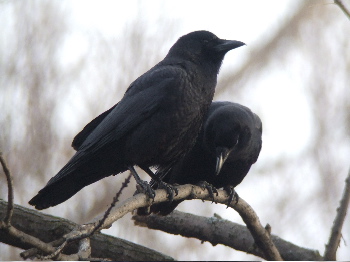
Nest: These birds build bulky stick nests, nearly always in trees but sometimes also in large bushes and, very rarely, on the ground. They will nest in a wide variety of trees, including large conifers, although oaks are most often used. Three to six eggs are laid and incubated for 18 days. The young are fledged usually by about 35 days. Normally single nesting, the species has been recorded as nesting in small colonies in the western parts of its range.
Voice: The most usual call is a loud, short, and rapid "caah-caah-caah". Usually, the birds thrust their heads up and down as they utter this call. Crows can also produce a wide variety of sounds and sometimes mimic noises made by other birds and animals.
Photo © Steve Huggins
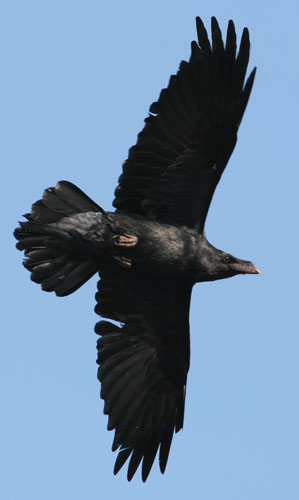
Raven is the common name given to several large black birds of the genus Corvus. Other birds in the same genus are the smaller crows, jackdaws, and rooks. The raven is much larger than the crow with a deeper call.
In much of Europe and North America, raven is used as a synonym for the widespread Common Raven, and much of the literature and culture surrounding ravens refers to that species.
Photo © Jeremy McClements
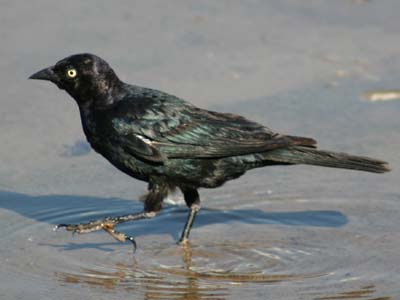
The Brewer's Blackbird (Euphagus cyanocephalus) is a medium-sized blackbird. Adults have a pointed bill. Adult males have black plumage; the female is dark grey. The male has a bright yellow eye; the female's is dark. They resemble the eastern member of the same genus, the Rusty Blackbird; however, this bird has a shorter bill and the male's head is iridescent purple. This bird is unrelated to the European Blackbird.
The iridescent purple head of the male is a distinguishing feature. Their breeding habitat is open and semi-open areas, often near water, across central and western North America. The cup nest can be located in various locations: in a tree, in tall grass or on a cliff. They often nest in colonies.
These birds are often permanent residents in the west. Other birds migrate to the southeastern United States and Mexico.
They forage in shallow water or in fields, mainly eating seeds and insects, some berries. They sometimes catch insects in flight. They feed in flocks outside of the breeding season, sometimes with other blackbirds.
The range of this bird has been expanding east in the Great Lakes region.
Photo © Tim Avery
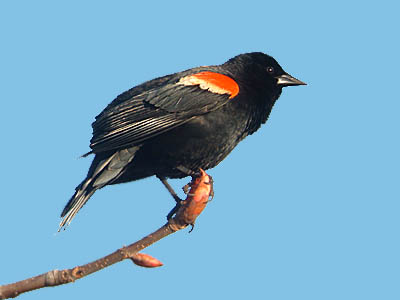
The Red-winged Blackbird, Agelaius phoeniceus, is a passerine bird of the family Icteridae, found in most of North America. These birds breed from Alaska and Newfoundland south to Florida, the Gulf of Mexico, and central Mexico, and winter as far north as Pennsylvania and British Columbia.
The common name is taken from the male bird's distinctive red shoulder patches, or "epaulets", which are visible when the bird is flying or displaying. At rest, the male shows a paler yellow wingbar against a black background. The female is an inconspicuous shade of brown and considerably smaller than than the male. The adult birds are from 7 to 9.5 inches (17 to 24 cm) long, and have distinctive sharp bills.
Female
They feed primarily on plant seeds, including weeds and waste grain, but about a quarter of their diet consists of insects, spiders, mollusks and other small animals. In season, they eat blueberries, blackberries, and other fruit. They can be lured to backyard bird feeders by bread and seed mixtures.
When migrating north, these birds travel in single-sex flocks, and the males usually arrive a few days before the females. Once they have reached the location where they plan to breed, the males stake out territories by singing. They defend their territory aggressively, both against other male Red-winged Blackbirds and against birds they perceive as threatening, including crows, Osprey, and hawks.
Red-winged Blackbirds prefer marshes, but will nest near any body of water. Pairs raise two or three clutches per season, in a new nest for each clutch. The nests are cups of vegetation, and are either built in shrubs or attached to marsh grass. A clutch comprises three to five eggs. These are incubated by the female and hatch in 11-12 days. Red-winged blackbirds are born blind and naked, but are ready to leave the nest ten days after they hatch.

Red-winged Blackbirds are polygynous, with territorial males defending up to 10 females. However, females frequently copulate with males other than their social mate and often lay clutches of mixed paternity.
When breeding season is over, Red-winged Blackbirds gather in huge flocks, sometimes numbering in the millions. In some parts of the United States, they are considered to be pests because these flocks can consume large amounts of cultivated grain or rice. This bird's numbers are declining due to habitat loss and the use of poison to prevent this loss of crops.
Photo © Robert Hughes
Photo © Kanae Hirabayashi

males are glossy black - females duller brown. Note long tail.
The Common Grackle, Quiscalus quiscula, is a large blackbird.
The 32 cm long adults have a long dark bill, a pale yellowish eye and a long tail; their plumage is an iridescent black. Adult females are slightly smaller and less glossy.<
Their breeding habitat is open and semi-open areas across North America east of the Rocky Mountains. The nest is a well-concealed cup in dense trees or shrubs, usually near water; sometimes, they will nest in cavities or in man-made structures. They often nest in colonies, some being quite large.
This bird is a permanent resident in much of its range. Northern birds migrate in flocks to the southeastern United States.
These birds forage on the ground, in shallow water or in shrubs; they will steal food from other birds. They are omnivorous, eating insects, minnows, frogs, eggs, berries, seeds and grain, even small birds.
This bird's song is particularly harsh, especially when a flock of these birds are calling.
The range of this bird expanded west as forests were cleared. In some areas, they are now considered a pest by farmers because of their large numbers and fondness for grain.
Photo © Rich Hoyer
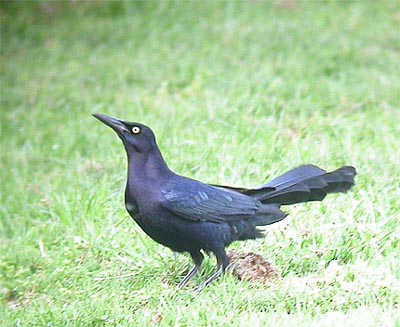
expanding range from west. Note very long tail. Loud bubbling calls.
The Great-tailed Grackle (Quiscalus mexicanus) is a large icterid blackbird , also referred to simply as "blackbird", and occasionally "crow" or "jackdaw", though it is not a member of the Corvidae. Similarly, it is often called "cuervo" in areas of Mexico where there are no true crows.
Its habitat ranges from Kansas in the northeast and southern California in the west to northwest Peru and northwest Venezuela; the grackle's range has been expanding north and west in recent years. It is common in Texas and Arizona in the southern regions. It is commonly found in agricultural regions and suburban environments, feeding on fruits, seeds, and invertebrates.
There is a considerable amount of sexual dimorphism in this species. Males reach up to 43 cm (18 inches), including a tail that is almost as long as the body, weigh 230 g, and are jet-black with a violet-blue iridescent sheen to the feathers. Females are significantly smaller at 33 cm (13 inches), weigh 125 g, and are mainly brownish-black, with a pale brown throat and belly.
This bird has a large variety of raucous, cacophonous calls, and is widely considered to be a noisy pest species, though its range expansion has not been aided by human introduction (compared to the European Starling).
Photo © Michael P Retter
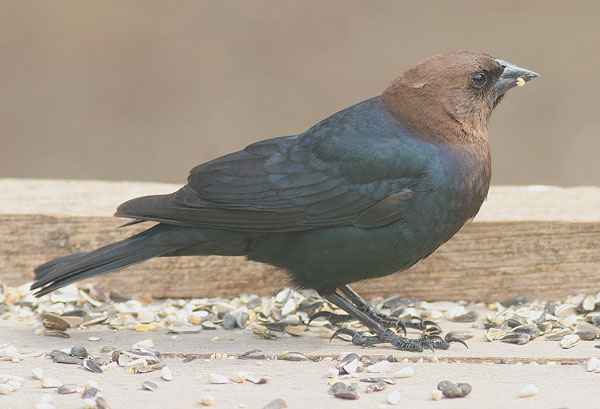
males are black with brown head and females are brown all over. Male pictured above and female below.
Adults have a short finch-like bill and dark eyes. The adult male is mainly iridescent black with a brown head. The adult female is grey with a pale throat and fine streaking on the underparts.
Breeding in open or semi-open country across most of North America, this bird is a brood parasite: it lays its eggs in the nests of other small passerines (perching birds), particularly those that build cup-like nests, such as the Yellow Warbler. The young cowbird is fed by the host parents at the expense of their own young.
Brown-headed Cowbirds are permanent residents in the southern parts of their range; northern birds migrate to the southern United States and Mexico. They often travel in flocks, sometimes mixed with Red-winged Blackbirds or European Starlings.
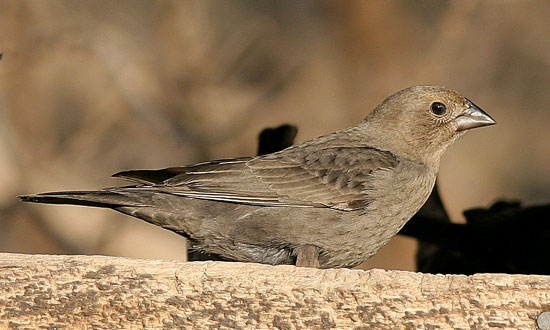
These birds forage on the ground, often following grazing animals such as horses and cows to catch insects stirred up by the larger animals. They mainly eat seeds and insects.
At one time, the Brown-headed Cowbird followed the bison herds across the prairies. Their parasitic nesting behaviour complemented this nomadic lifestyle. Their numbers expanded with the clearing of forested areas and the introduction of new grazing animals by settlers across North America. Brown-headed Cowbirds are now commonly seen at suburban birdfeeders.
Brown-headed Cowbird females can lay 36 eggs in a season. Over 140 different species of birds are known to have raised young cowbirds. Host parents may sometimes notice the cowbird egg. Different species react in different ways. Gray Catbirds destroy the egg by pecking it. Some species may simply build a new layer over the bottom of the original nest. Brown-headed cowbird nestlings are sometimes expelled from the nest.
Photos © Mark S. Szantyr
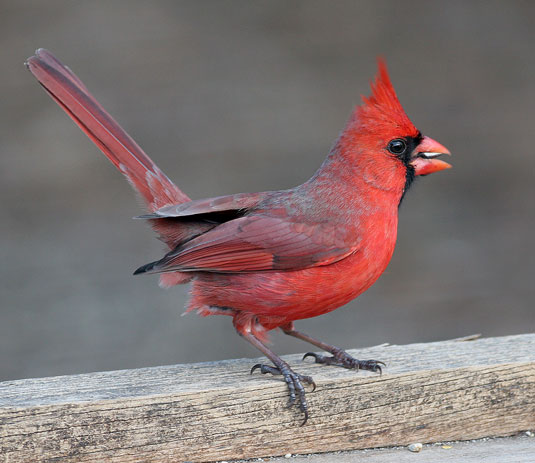
unmistakeable. Calls are a loud chip. Juveniles resemble adults but are brown.
These are robust, seed-eating birds, with strong bills. They are typically associated with open woodland. The sexes usually have distinct plumages; the family is named for the red colour (like that of a Catholic cardinal's vestments) of males of the type species, the Northern Cardinal.
The "buntings" in this family are sometimes generically known as "tropical buntings" (though not all live in the tropics) or "North American buntings" (though there are other buntings in North America) to distinguish them from the true buntings. Likewise the grosbeaks in this family are sometimes called "cardinal-grosbeaks" to distinguish them from other grosbeaks. The name "cardinal-grosbeak" can also apply to this family as a whole.
Photo © Mark S. Szantyr